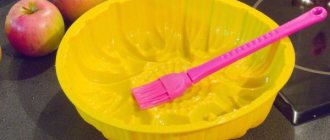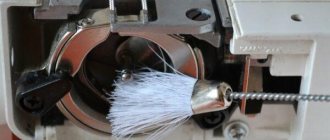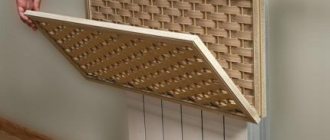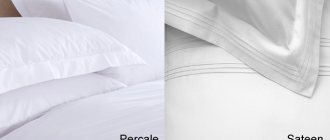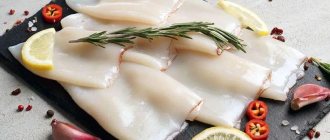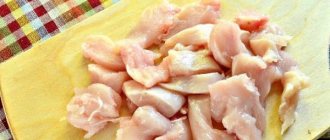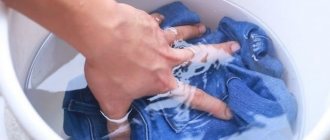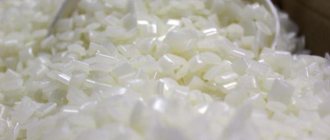Why do hinges begin to creak?
Creaking door sounds occur for several reasons, and they often appear in cars with a short service life:
- multiple opening/closing;
- unfavorable weather conditions;
- wear of the rubber bands responsible for the tight fit of the door to the body;
- poor-quality factory lubricant;
- door sagging;
- poor quality assembly of components, which is especially noticeable in domestic cars;
- very frequent washing of the car, because water, coupled with chemicals, washes out the lubricant;
- washing the car too rarely, as a result of which the lubricant becomes clogged with dirt.
However, even with systematic care of a good quality car, there is a possibility of door squeaks.
Lubricants for car door hinges
Stores offer a wide selection of lubricants with different characteristics - it all depends on the preferences of the car owner. A lubricant for car door hinges is in demand among car enthusiasts; it prevents the formation of a corrosive coating for a long time - when applied, it creates a water-repellent layer on the hinge. Other compositions have high penetrating qualities, while others relieve working units from loads - dynamic and static.
Which lubricant to choose for car door hinges
Car doors should be lubricated with consistency compounds that have good penetration into the gaps and create a moisture-reflecting coating on the surface of the components. The material must:
- have excellent anti-corrosion qualities;
- minimize friction of elements;
- be resistant to temperature fluctuations;
- have a long service life;
- reduce friction of mating surfaces.
Choose a composition with little fluidity - too liquid ones will instantly lose their functions. If the store does not have a full-fledged lubricant, you can temporarily replace it with a grease material. Such compositions have good permeability and quickly neutralize annoying squeaking. Motor oil or lithol is also used. However, the oil evaporates quickly, and lithol is incredibly sticky, so it instantly attracts particles of debris.
Common lubricants
Lubricants for coating hinges in cars are divided into 2 groups - polymer and mineral.
Polymer
Polymer compositions are made on a silicone base. The lubricant is able to withstand severe temperature changes and other loads without loss of properties. Polymer lubricant is produced in tubes and in spray form. When working with paste from a tube, it is necessary to protect the skin of your hands with gloves. Spray lubricant is more convenient to use, as it allows you to reach hard-to-reach places.
Attention! Another type of polymer lubricant is technical petroleum jelly, but it is rarely used due to the poor quality of the product.
Mineral
Unlike polymer analogs, mineral coatings are more durable due to their consistency. In winter, they perfectly protect the door mechanism from moisture. One of the popular types of mineral lubricant includes lithium - it creates a strong barrier to moisture and reduces friction of door parts. Perhaps the only drawback of the product is poor protection of the hinges from corrosion. Places where the lubricant is applied in a thin layer succumb to rust faster.
Effective lubricants
After reading the top five, you will learn how to lubricate a car door to prevent squeaking:
- Liqui Moly Wartungs Spray Weiss.
- Wurth HHS 2000.
- CRC-MULTILUBE.
- Permatex 80075.
- Klever Ballistol-Silicon Spray.
Liqui Moly Wartungs
Liqui Moly is a common whitish-colored product containing microceramics. It has anti-corrosion and moisture-repellent characteristics, prevents the penetration of dirt particles into the door mechanism for a long time and reduces friction of structural parts.
Liqui Moly Wartungs Spray Weiss is a specialized product designed for processing movable parts, keyholes, hinges, rods, etc. The product is based on mineral oil. Temperature range of application - from -30° C to +250° C.
Advice! The Liqui Moly Wartungs composition can be used to coat not only hinges, but also all kinds of moving parts of a car.
Wurth HHS 2000
Wurth HHS 2000 lubricant is a product of German manufacturers that has won the special love of car enthusiasts. Car owners liked the lubricant due to its rapid thickening, excellent adhesive and penetrating properties, and good stickiness. Ideal for application to door hinges, locks, stops. The product is resistant to strong water pressure and prolongs the service life of mechanisms, even those operating under high pressure.
The main highlight of Wurth HHS 2000 is its rapid transformation from an aerosol to a thick lubricant. Thanks to this property, it reaches hard-to-reach places and remains there for a long time, protecting elements from moisture and reducing friction. The operating temperature range is from -30° C to +180° C. The main disadvantage is the adhesion of grains of sand, dust, and other debris. Plus - low cost.
CRC-MULTILUBE
A universal lubricating composition with high penetrating and water-repellent characteristics. Gets into the most difficult areas of mechanisms, creating a durable protective film. Thus, it significantly reduces the friction of the joints and prolongs their service life. Retains original lubricating properties even with sudden temperature changes.
Multilube has a distinctive feature - a bright blue color, which indicates areas not yet covered with the composition. Thanks to this, the car owner immediately sees where the lubricant is applied. A few days after processing the mechanisms, the product becomes discolored.
Permatex 80075
Permatex 80075 is a colorless lubricant that perfectly protects moving parts of door hinges from wear. Extends the service life of mechanisms and has high anti-corrosion properties. It is in a liquid state in the container, but at the moment of spraying it turns into foam. This allows the compound to reach hard-to-reach places, protecting hinge elements and keyholes from wear and squeaking.
Klever Ballistol-Silicon Spray
One of the materials used not only for processing metal parts, but also spare parts made of plastic, rubber and rubber. Provides a sliding effect of rubbing elements, significantly extending the service life of door “joints”. The spray contains silicone, which allows it to be used at any time of the year - both in cold and heat.
Attention! The universal fluid WD-40, known to most car enthusiasts, or simply “Vedeshka”, has excellent anti-corrosion properties, but quickly washes out the lubricant.
How can you lubricate car hinges?
The question is quite vague. You can lubricate it with anything, even pork fat, but the effect of such treatment will be weak and short-lived.
Having studied the issue, the author of Miss Clean magazine recommends avoiding lubrication with vegetable oils (including olive and sunflower) and WD-40 spray. The first ones coke, and the mechanism stands up tightly. The second one is more suitable as a wash; the protective effect will be short-lived.
Experts note that any lubricant labeled as grease will be optimal. These materials are not liquid or solid, they are plastic, and thanks to this they stay on the parts longer and protect them as much as possible from friction.
Despite its viscous consistency, lithol is not the best option: it picks up dirt and the mechanism quickly becomes clogged. Solid oil is also not quite suitable, first of all, because it does not hold high temperatures well, it leaks when heated, and accordingly, it quickly drains and fills adjacent cavities, dirtying the interior.
Advice Some lubricants acquire the desired consistency after application, and are distributed from a container as a spray - this is an ideal option, although they are more expensive.
Characteristics of a good lubricant:
- plastic,
- wear resistance,
- good adhesion to metal and plastic,
- ability to repel dirt,
- resistance to high and low temperatures, to their differences,
- water-repellent effect and, as a result, protection against corrosion and icing.
We recommend: How to polish with GOI paste: professional advice and useful information
It is also desirable that the lubricant be tolerant, that is, it does not corrode or tan plastic, silicone and rubber parts. This product is universal, suitable not only for hinges, but also for locks and other parts, and the owner does not have to buy a separate lubricant.
Recommended brands, according to auto sites:
- Wurth HHS 2000 is an expensive, but nevertheless popular lubricant from a German manufacturer. Retains its qualities in cold temperatures just below 30 degrees, and maintains the heat possible in a car. One of the key benefits is that the consistency changes from aerosol to thick lubricant within minutes. It is also worth noting that Wurth HHS 2000 is resistant to washing off, even under pressure. The weak point is increased adhesion, due to which the lubricant picks up dirt relatively strongly.
- Liqui Moly Wartungs-Spray Weiss is also expensive. Its uniqueness is the ceramic powder in its composition and the mineral base. It performs well in temperate climates, but the lower operating limit is –30, which should not be forgotten. The upper limit is impressive: the lubricant lasts up to +250 degrees Celsius. Compared to the previous one, it is washed off faster with water and does not withstand the impacts of a water jet.
- CRC-Multilube ranks either third or second in popularity in various ratings. It has good penetrating ability and a wide operating temperature range. Competitive advantage is the color of the lubricant. When applied, it is blue, which allows you to track which areas have been treated and which areas have been skipped. After some time, the layer becomes colorless.
- Permatex 80075 is another example of a good lubricant. It has a foam consistency when applied and excellent penetration.
- Klever Ballistol Silicone Spray is an example of a successful silicone lubricant. Its main advantage is its versatility and tolerance to most materials. Disadvantage: the layer is washed out relatively quickly.
Advice Silicone-based lubricants give a good effect and are relatively inexpensive, but they are not the most stable, and the layer will have to be renewed at least 4 times a year. This is partly compensated for by additives, so it is worth paying attention to non-multicomponent lubricants with silicone as an alternative to purely silicone samples.
What is the best way to lubricate car door hinges?
To lubricate door hinges, it is better to choose compounds that meet the following criteria:
- prevention and destruction of rust;
- maintaining properties at very low or too high temperatures;
- maximum friction reduction;
- penetration into hard-to-reach places;
- long service period;
- low price with good quality.
It is important to buy products that have fluidity - otherwise, the interior and body of the car will be difficult to wash off stains. Many drivers like products based on molybdenum disulfide. This product is excellent for bearings, transmissions and engines, but you should not lubricate door “joints” with it - the product is easily soiled and attracts a lot of dirt.
How to properly lubricate hinges
It is a misconception that to eliminate squeaking it is enough to spray the hinges on top with an aerosol or treat only the working parts. The effect will be, but short-lived, and soon the creaking sound will return.
- You must first remove any accumulated dirt from the hinges using a wide brush. It will not be possible to do this simply, since sand and dust particles are mixed with a lubricant - you will have to treat it with regular gasoline or white spirit.
- Remove gasoline residues with dirt, as well as traces of corrosion using a rust converter.
- Apply new compound to the hinges. The effect will be greater if the mechanism is not completely filled with the product, but only the surfaces of the mating areas are smeared. Wipe off excess product with a rag.
- Open and close the door 15-20 times to evenly distribute the lubricating components throughout the hinge. Also remove excess with a rag.
If after lubrication the doors continue to creak, there are a number of reasons for this:
- the lubricant was of poor quality/outdated;
- the doors sagged;
- old grease was poorly removed, leaving debris particles.
Important advice! It is best to process the loops after washing, in the autumn, when there is no longer any heat, but the cold has not yet set in.
How to lubricate step by step
Lubricating hinges was once a creative process that required experience and dexterity. This was due to the consistency and packaging of the lubricant, as well as the design of the hinges. Today, lubricant for cars is produced in cylinders with a proboscis nozzle. This allows you to “fill” the material pointwise and deep enough, rather than filling the entire surface. The hinges themselves have a movable rod, and it is enough to treat it with protection.
We recommend: Methods of using phosphoric acid against rust
Instructions:
- Open the car door.
- Use a rag to remove any initial dirt from the hinge.
- Spray with a remover, such as WD-40, and remove any remaining dirt and old grease.
- If corrosion is visible on metal parts, use a rust converter. Remove any remaining oxide and apply anti-corrosion protection (the latter is not necessary if a high-quality lubricant with anti-corrosion protection is used).
- Having fitted the proboscis nozzle, distribute the lubricant onto the moving parts of the loop.
- Use a napkin to remove excess material and drips.
- Close and open the door several times (up to 25).
- Open and remove any excess that appears. Wipe the door, seal, body sill and part of the interior if grease gets there.
- Close the door.
Lubrication procedure
It is impossible to fully carry out the procedure for lubricating the door hinge without disassembling the mechanism. So, to process the parts you need:
- Arm yourself with an open-end wrench and unscrew the bolt securing the locks.
- Slide the door handle in the direction opposite to the door opening and remove it.
- If the handle does not come off, you should slightly rock it in different directions.
- Find a couple of levers inside the door and carefully apply lubricant to them.
- Also treat the inside of movable locking elements and handles. The locking mechanism can be reached by removing the protective plastic cover.
- Remove excess lubricant with a rag.
- Reinstall the lock and handle.
- Open and close the door several times, listening to see if the squeak remains.
In order not to constantly disassemble the locking mechanism, you can use an aerosol with a special tube. Insert one end of the tube into the lock, the other into the sprayer.
Another unpleasant moment characteristic of the winter-spring season is the freezing of the door along the contour of the seal. This often happens after washing the car or during a thaw, when the daytime temperature rises and drops sharply in the evening. In this case, there is a risk of tearing off the seals or not opening the car door at all. Silicone lubricant designed for rubber products can be a salvation.
An unpleasant squeak when opening/closing a car door can be prevented if you regularly, at least 1-2 times a year, apply a lubricant to the stops and hinges. This can be done using a 25 cc medical syringe.
Don’t be lazy - before winter, be sure to remove the locks and lubricate the door mechanisms from the inside. This way you will protect them from rapid wear and tear and save yourself from the unpleasant creaking sound.
Do not leave the car wash in cold weather without drying your car first. Spend 5-10 minutes drying, and to speed up the effect, open and close the doors several times in turn. Excess moisture will drain out on its own, and you will have peace of mind for your car.
Why do you need to lubricate car doors?
Car doors are used several times a day, the frequency of opening and closing starts from four times and can reach several dozen times. The door mechanism consists of rubbing parts that are subject to rapid wear. What if we add here the ingress of dust, water and dirt, which only aggravate this difficult situation? Problems are indicated by creaking hinges and a sticking lock. If you don’t take care of your car, then all these troubles will manifest themselves. But is it worth bringing it to this state if you can regularly lubricate the hinges and not worry about their condition in the future.
